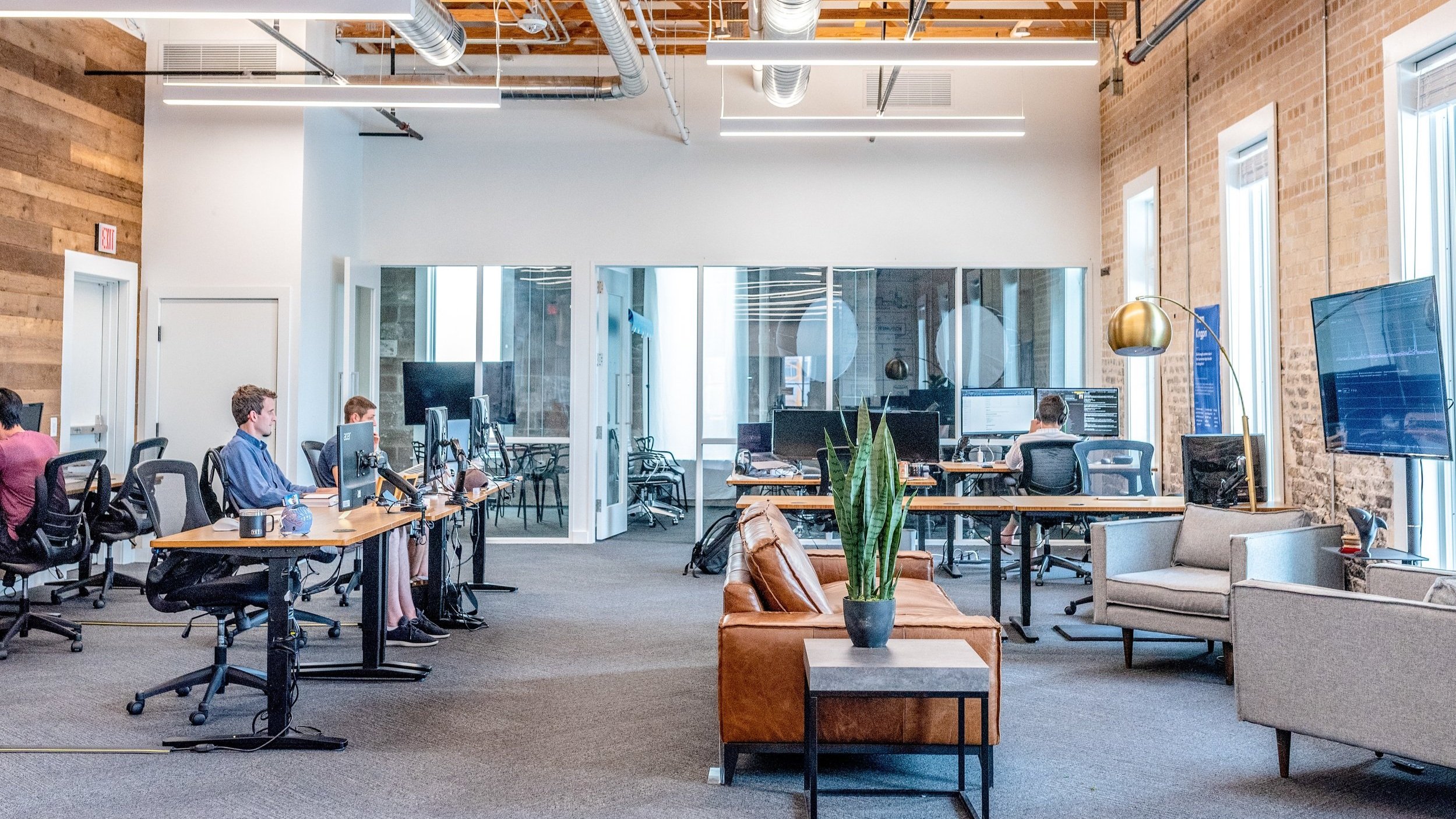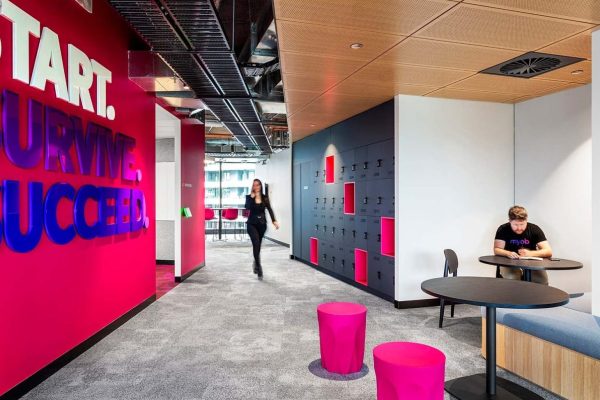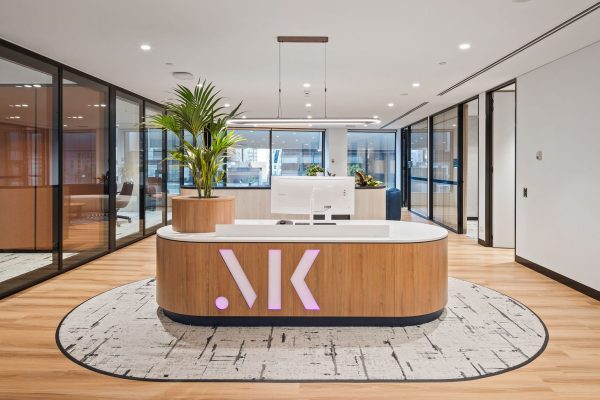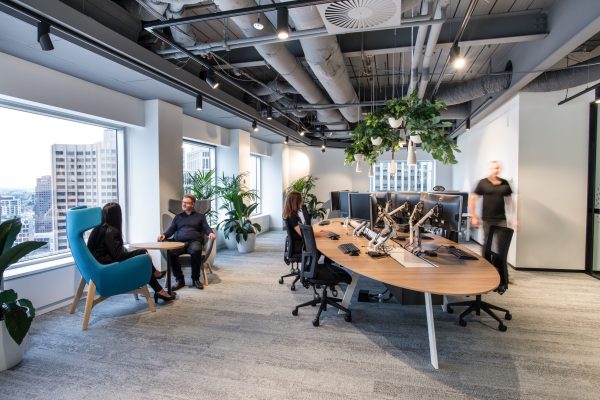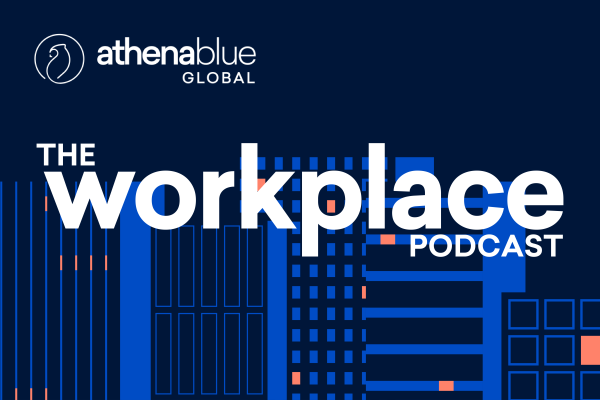Leaders are all too aware of this, and the pressure to adapt can even be overwhelming. There’s a lot to do, at a time when leaders have little room left to take on additional responsibilities. It can also be challenging to figure out where to start, and to decide how to optimise efforts and investments. And even the most carefully developed plans may meet scepticism or resistance.
To optimise efforts and create alignment, organisations need to reassess the following four key areas.
01 – Physical space and technology
The physical environment has an immense role in supporting people’s performance. The right spaces enable people to access the tools and resources they need, connect with others (at the right times), and immerse themselves in their tasks, with full attention. Spaces and technology solutions need to work seamlessly together, supporting a variety of individual tasks and team activities – including in-person, hybrid and virtual collaboration. Technology can – and should – also play an important role in collecting and analysing data about work patterns, and about how the physical space is used. These insights can be valuable for optimising the workplace and improving work practices.
However, before making decisions about the workplace and technologies, it’s critical to understand how people do their best work, and what practices allow them to thrive.
02 – Ways of working
What kind of individual and team activities do people need to engage in, to help support the organisation’s goals? What tools and resources do they need for the different tasks? How do they need to think and act in different situations, to achieve the best outcomes? What habits and distractions should they avoid? What kind of environments support focus, creative thinking, problem-solving or relationship building? Where can people find inspiration and motivation? When is it a good time for teams to come together in person? When can they effectively collaborate remotely, or in a hybrid set-up? What are the best times and places to socialise, play or relax?
These are just some of the questions that need to be answered, to optimise performance. Adapting ways of working is a complex challenge. But it’s certainly achievable, with the right style of management and leadership.
03 – Management and leadership styles
Work styles vary greatly. When leaders and managers try to figure out by themselves how their teams do their best work, they naturally make plenty of assumptions. Adding to the challenges, individuals may be less inclined to adapt how they work, if they haven’t been brought on the journey. In contrast, when everyone participates, teams can optimise their ways of working with the least amount of tension and the greatest efficiency.

A capable and astute team, with high work style awareness – even when provided with a state-of-the-art office – will not necessarily thrive. The full potential of a great workplace and well-thought-out work practices can only come to fruition if the qualities of the space, technology, work practices and management styles are fully aligned.
Organisations need to coordinate individual work styles with team and organisational practices, and enhance experience levels with learning and development opportunities. It’s essential to balance structure with appropriate levels of autonomy – which not only enables people to work in ways they are most effective, but also allows them to look after their own needs.
Ways people are nurtured and empowered
Offering perks and ‘wellbeing spaces’ are only surface-level solutions. Employees desire increasing support and tailored initiatives that will allow them to work more effectively, maintain their physical and mental health, and feel they belong. Many leading organisations are adopting less hierarchical structures, and transitioning from managing to coaching their teams, which often proves to be a more conducive model to nurture individual potential.
Middle managers need tailored support as well, for a variety of reasons. Having to address their people’s individual needs imposes increasing responsibilities on them. In addition, they are tasked to lead teams through unprecedented change. Altering their management styles, and perhaps having to let go of some of their perceived control, can also be a daunting quest. Organisations need to provide training and resources to support middle managers to meet these challenges.
The good news is, when leadership and management styles, work environments and practices are aligned, everyone’s life becomes easier. Team cohesion, trust and engagement grows, and instead of individuals focusing on trade-offs and compromises, people start to pull in the same direction, with combined efforts.
However, to achieve this alignment, organisations need to define what high performance mean to them, clearly and thoughtfully.
04 – Defining measures of performance
When leaders try to set targets for something as complex as workplace performance, it can be tempting to look for metrics that are easy to measure and quantify. Traditionally, performance was often measured by the amount of time employees spent in the office or in front of their screens. However, in knowledge-based and service-based industries, these metrics do not capture the full breadth of performance.
A better place to start is to unpack the organisation’s purpose and values, and what these mean in the daily practice. Leaders and managers need to provide clarity on what they are seeking to achieve, and create the right conditions where everyone can utilise and extend their skills and talent – which is just as important to employees as it is to employers. Clear directions and performance indicators make it easier to develop focused and motivated teams.
The most meaningful performance measures are unique to each organisation. So, instead of trying to copy competitors’ strategies, investing in comprehensive internal research and planning will lead to greater clarity around meaningful indicators. It’s worth keeping in mind that employees are the largest expense for many organisations, and even relatively small improvements in employee performance – which may be measured, for example, by productivity, innovation, or customer satisfaction – can lead to significant leaps in achieving business objectives.
Optimising efforts
Thoughtful, effective adaptation requires time investment and commitment, as well as open and honest conversations. It’s important to acknowledge that certain trends – such as people’s increased expectations for work–life balance – cannot be reversed, while other changes – including digital transformation – are inevitable.
But this doesn’t need to be overwhelming. What drains energy and spirit is defending decisions based on guesswork, playing tug of war with leaders and team members on opposing sides, or holding onto familiar structures that no longer serve the organisations’ objectives in the changing landscape of work.
So, where to start?
- Define what workplace performance means to your organisation, and what the key indicators are.
- Identify what leadership and management styles can help the organisation achieve its purpose, and how people can be supported through the transformation.
- Rethink work practices and processes, to ensure all individuals and teams can effectively contribute. Educate and guide people to develop work styles that allow them to excel.
- Design physical environments and technology solutions that work seamlessly together, enable optimised work practices, and allow individuals and teams to thrive.
Adaptation doesn’t have to involve piling more responsibilities on leaders and managers. Instead, we’re talking about finding common ground and creating alignment. Adaptation requires asking purposeful questions, reviewing priorities, and inviting everyone to play to their strengths.
With this approach, organisations can create a physical, technological and cultural environment where adaptation is a straightforward, enjoyable and rewarding process. What will the office space look like? It will only be revealed at the other end. But one thing is certain: it will be an environment where all efforts are orchestrated to help the organisation succeed.

Athena Blue Global specialises in equipping leaders with the tools needed to make workplace decisions through our Workplace Strategy services. Contact us to learn more about building your next strategy for your workplace and people.

